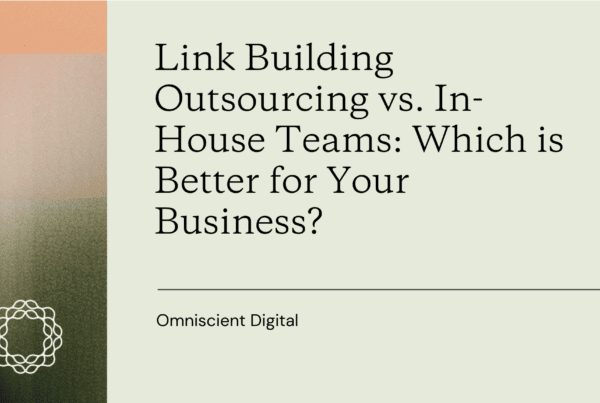
Before we jump in, first navigate to Google on your phone or computer and do a search for restaurant recommendations.
What did you type?
Maybe you searched for, “best brunch in [insert your city]” or “best restaurants in [your city] 2017” or “why this is idiot telling me to do a Google search?”
Ten years ago, a typical Google search might have been, “[city] breakfast.”
Now, besides brunch becoming more popular in the last ten years, a big change in consumer search behavior is that we now search using complete phrases and expect Google and other search engines to understand what we want.
On top of that, when you do a search on mobile, if we do a search for “brunch near me,” we expect the search engine to be smart enough to know where we are and give us a list of brunches places in order of distance and reviews.

What’s Happening with Content and Search?
Searchers are changing.
Due to improvements in technology, consumers’ expectations of search engines have changed.
Because of this, marketers need to change their content strategy to match the way consumers search.
Two examples of this technology change are mobile phones and voice search.
Voice search now accounts for 20% of Google searches and it’s continuing to grow.
With assistant software like Siri, Google Assistant, Microsoft Cortana, and Amazon Echo, consumers are using voice search more and more.
While there isn’t direct data that tells you whether a search was done through voice or text, we can tell whether a search was done via voice because of the conversational nature of the query rather than the fragmented terms of search’s past.
For example, you can look at the growth of question queries which include “who,” “what,” “where,” “when,” “why,” and “how.”

Consumers will ask search engines complex questions using full sentences.
As a result, Google’s updates over the last 2-3 years have focused on understanding these types of queries better through natural language processing, most notably with the rollout of Hummingbird in 2013. The algorithm is focused on analyzing phrases instead of individual or short strings of keywords.
In the past, marketers traditionally focused on optimizing for big keywords that were often one or two-word queries. Then we shifted to optimize for long-tail keywords.
Now we need to optimize for conversational queries of which there are hundreds or thousands of long-tail variations that are regularly searched and change based on location.
For example, we might optimize for “best cheesecake recipe” but someone doing a voice search might say, “How do I bake a cheesecake?” or “What’s the best cheesecake recipe?”
There lies the challenge: how do you optimize your content for thousands of variations of long-tail queries?
The Downfall of Content Marketing
It’s clear that we need to change the way we do content to adapt to the changing nature of search. This is a cultural shift in marketing that will to take time to change.
Previously, marketers followed a process to write blog posts:
- Do keyword research
- Decide on a keyword you want to rank for
- Write a blog post that’s optimized for that keyword
- Repeat for more keywords
They focused on optimizing each blog post for a search query that was usually made up of one or two words.
So they wrote one blog post for every keyword they wanted to rank for.
Eventually, marketers shifted to optimized for long-tail keywords – queries with five or more words and lower search volume.
So the above process turned into:
- Do long-tail keyword research
- Decide on a long-tail keyword you want to rank for
- Write a blog post that’s optimized for that long-tail keyword
- Repeat for more long-tail keywords
There wasn’t much of a difference.
Because they wanted to rank for so many keywords, they had to write a lot of blog posts. Because they needed to generate so much content, the quality of the content decreased.
What’s scary for me is that in a 2017 survey by Content Marketing Institute, 70% of B2B marketers surveyed said they were going to create more content in 2017 than they did in 2016.
When you look at data from HubSpot’s State of Inbound 2017, we see responses consistent with the idea of creating more content.

That’s a lot of freaken content. Imagine how much content is going to be created in 2018.
Content creation isn’t necessarily bad, but…
Ten years ago, Dharmesh Shah and Brian Halligan, the co-founders of HubSpot, wrote a book aptly called Inbound Marketing.
The key point of the book was that marketers should add value by creating content.
During his keynote at INBOUND 2017 (click to watch video), Dharmesh Shah shared an observation of the last 10 years :

Because of this intense focus on creating content, the volume of content created skyrocketed. You can see the increase in content creation from posting activity on WordPress.

But if each blog post ranks for one keyword…
How do you optimize content for thousands of long-tail queries?
So we’re faced with two challenges:
- The changing nature of searchers and search algorithms
- Increasing competition from other businesses and influencers
To take on those challenges, we need to:
- Create quality content that provides value. This is nothing new, but it seems like many marketers have either lost sight of this or haven’t been set up for success to focus on this. For example, there are many businesses where managers who don’t understand marketing tell marketers to churn out blog posts because they heard they’re supposed to be blogging.
- Switch our content strategy from focusing on one keyword per blog post to focusing on a topic. We need to rethink how we can target multiple longtail query phrase without creating a blog post per search term.
This post will help you solve for #2, and through solving for that challenge, you’ll solve for #1.
Before we get into that, let’s start with basics and work our way out from there.
What is a Content Strategy?
A content strategy defines why you create content, how you create it, and what you’re going to create. It helps you map content creation to business growth.
With a content strategy in place, the content you create will be informational and helpful – maybe even entertaining – and build trust with your audience. That trust will ideally turn into a relationship and a business transaction.
The content strategy we’re going to discuss is focused on topics over keywords. We’ll call this the Topic Cluster Strategy.
Want help implementing the topic cluster strategy? I’ll walk you through how you can apply this framework to your content. Get in touch.
The Topic Cluster Strategy allows you to cover a range of core topics with fewer pieces of content while creating an effective information architecture across your website. It is composed of two components:
- Pillar content
- Cluster content
We start by creating a piece of pillar content for a broad topic that’s comprehensive and helpful. Then we create shorter pieces of cluster content that dives deeper into a specific area of the broad topic. This group of content is what we call a topic cluster.

(Source: HubSpot Research)
Site Architecture Through the Lens of SEO
Before we talk about why the topic cluster model is better for SEO, it helps to review how SEO is passed among pages.
Before the shift to topic clusters, HubSpot’s internal linking structure looked like this.

The homepage is generally the strongest in terms of SEO and, in our case, it links to the blog subdomain.
As HubSpot produced more content, the structure became more spread out and complex with no organized linking structure in place.
This lack of organization made HubSpot’s website suboptimal for search engines to crawl the pages quickly, in a way that was beneficial to our SEO.
However, this is how the websites of many other businesses are structured.
We create a lot of content and eventually we realize there are dozens of pages with very similar content. These pages end up competing with each other to rank in the SERPs.
A more organized structure is needed to tell search engines what pages should be prioritized.
Here’s what that looks like:

The homepage links to the large circles, the pillar pages, and the pillar pages link to various pieces of cluster content around the same topic.
By rearranging the internal linking structure into clusters like the image above, search engines can easily scan all the content and understand that there is a semantic relationship between the pages’ content.
The cluster set up signals to search engines that there is breadth and depth to the content, which gives the pillar page more authority and credibility on the topic and a higher ranking in the SERPs.
Here’s an example of what one of those clusters might look like:

Ideally, you would have a short list of pillar content that is optimized for a topic and the rest of your content is created to support those pillars and linking to them. This allows your content creation to be more focused and strategic instead of writing about every topic.
What happens when you adopt this strategy?
In 2015, I was on a small experimental marketing team within HubSpot and we launched a topic cluster experiment for a select group of topics and semantic keywords. We found that the more internal linking we did, the better the content ranked in the SERPs. The more internal links we added, the more organic views we received.

Here is the organic traffic performance of one of the blog posts we published in 2014, then put into a content cluster in 2015.

- We launched this post in late 2014 and saw some organic traffic kick in.
- In early 2015, the post saw a few spikes in traffic but always dipped back down again.
- In the summer of 2015, we republished the post with optimized links to a new, related pillar page, and create more related content to add to the content cluster. We saw organic traffic spike again
- After the re-publish with the topic cluster, organic traffic didn’t dip again but continued to grow at a new bar of weekly search traffic.
But that was one small team running an experiment. You probably already have a blog and already have a lot of content. So how do you apply the Topic Cluster Strategy to your existing content?
How to Apply the Topic Cluster Model to Your Content
Before going on, let’s do a quick recap on SEO today:
- Focus on topics instead of keywords
- Own topics across multiple posts instead of one keyword per post
- Create a self-contained internal linking structure within clusters
- On-page optimization still matters
- External link-building still matters
With that in mind, let’s jump into how you can apply the topic cluster model to your existing content.
0. Remove all internal links from your blog posts.
Goal: Reset your internal linking structure.
Remove all links that point to another piece of content on your website. You can keep any external links. (Yes. This will be painful and time-consuming.)
1. List the challenges your product or service solves for.
Goal: Start with the business before creating topic clusters.
Use surveys and customer interviews to understand the top 5-10 core challenges that your buyer persona has that your product or service helps with. These will help you determine what broad topic areas you should create a content strategy around.
2. Group the challenges into broad topic areas.
Goal: Think about topics as they relate to your product or service.
Use this structure:

Start with your features or services and determine what challenges they solve for (you did this in step 1). Come up with topics under each of those challenges. These topics will come up in your surveys and interviews.
Then do keyword research for each topic to find angles to write about.
Cover topics with high search volume.
You can use a Google Sheet like the one below to organize how your features or services map to content topics.

3. Run a content audit and categorize your posts.
Goal: Know what content you already have.
Do a basic content audit to find what content you already have that maps to those challenges.
The easiest and quickest way to do this is to export a list of all your blog posts including their URLs and titles into a spreadsheet, then add a new column to label what broad topic the blog post fits under. You should be able to tell the topic of the post by the title.
That spreadsheet would look something like this:

4. Identify your pillar pages.
Goal: Avoid creating new content by identifying existing pillar pages.
Existing content can be used as pillar pages or turned into one. These pages generally:
- Have high quality, thorough, evergreen content
- Rank highly for a handful of keywords
- Get a lot of organic traffic
- Might have a lot of backlinks
If a piece of content has potential, you can update and refresh the content to turn it into a pillar page.
5. Find content gaps and duplicate content.
Goal: Decrease duplicate content.
You might find that you have pages that cover the same topics as other pages. You have four options:
- Unpublish: If a post has no editorial value, no search volume, and is not similar to another post, unpublish it. Unpublish any outdated posts.
- Consolidate: The page shares the exact same angle as another page but neither covers the topic well. Combine the content and redirect one post to the other.
- Redirect: The page isn’t valuable or is a duplicate of another post with better search equity. If neither page is ranking, redirect the newer page to the older page.
- Update: If the post is starting to get a good amount of organic traffic, covers an evergreen topic, and is not duplicate content, consider updating it. Read about historical blog optimization to learn how to do this effectively.
6. Optimize within your content clusters.
Goal: Create your content clusters.
At this point you’ve:
- Removed all internal links from blog posts
- Identified your pillar pages for each topic
- Categorized your blog posts
Now it’s time to add your internal links to restructure your content architecture. Each of your cluster content should link to your pillar page and three or four related pieces of cluster content.
Important: All posts in a cluster should only link to each other and their corresponding pillar page.
Repeat this for every cluster.
Yes. This will also be painful and time-consuming.
7. Set up reporting for each cluster.
Goal: Know how your clusters are performing.
Reporting is the tough part for this content strategy because all rank trackers still track using keywords.
At HubSpot, we use two tools:
Google Search Console is used to focus on the head keyword that your pillar pages are ideally ranking for. It lets you keep an eye on traffic, rank, and SERP clickthrough rate for select topics and helps you identify underdeveloped clusters. The downside is it doesn’t show you what page is ranking for the keyword.

On the other hand, Accuranker is used to track the ranking of your pillar page based on the select keyword. It gives you a broad look at changing rankings so you can dig in on any keywords where you’ve lost ranking.

The unfortunate part is that this method of reporting requires a lot of customization and there’s no easy or fast way to do this for free or even paid solutions.
(HubSpot is working on a way to do this easily with our Content Strategy tool.)
8. Create new content.
Goal: Create content only if it’s absolutely necessary.
You might have noticed that creating new content is the very last step of this process. That’s because you should focus on getting the most out of the content you already have. It’s generally easier to update and refresh existing content than creating new content from scratch.
It’s also beneficial to update older content because search algorithms trust older web pages more than new pages.
Follow the steps below to create new content (you’ve already done most of it!):
- Make sure you absolutely need to create new content
- Identify your content gaps
- Do research to identify the highest-value keywords within your topics
- Research and write the new post
- Do the usual on-page optimization of header tags, title, and keyword use
- Link the post into an existing cluster
Time to apply the topic cluster strategy to your content.
It’s a time-consuming process but this strategy has helped HubSpot’s website break our organic traffic plateau and continue to grow.
A more organized site structure will help your content strategy in the long-term as you continue creating more content and will remind you to map each piece of content to business growth.
Here are five steps to start today:

Editor’s note: This post was originally published at DavidLyKhim.com.



